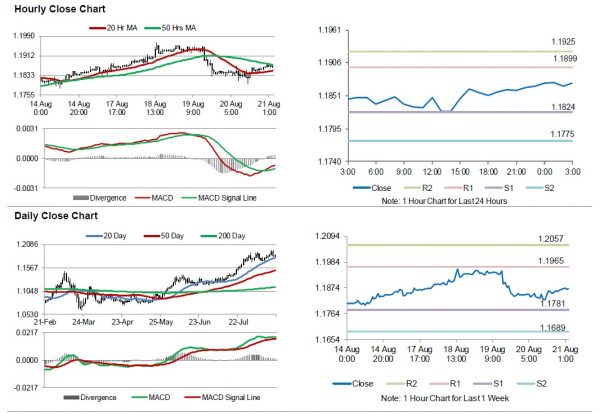For the 24 hours to 23:00 GMT, the EUR rose 0.15% against the USD and closed at 1.1867.
On the macro front, Eurozone’s seasonally adjusted construction output advanced 4.0% on a monthly basis in June, compared to a revised surge of 29.4% in the prior month. The European Central Bank (ECB), in its July monetary policy meeting accounts, warned that the Eurozone is likely to suffer a sharp increase in unemployment this autumn even as the economic recovery from the coronavirus pandemic takes hold. Moreover, the ECB policymakers expressed uncertainty about the economic outlook and the extent to which they would have to deploy monetary stimulus. Separately, Germany’s producer price index (PPI) fell 1.7% on an annual basis in July, less than market anticipations and compared to a drop of 1.8% in the previous month.
In the US, seasonally adjusted number of initial jobless claims unexpectedly rose to a level of 1106.0 K in the week ended 14 August 2020, compared to a revised level of 971.0 K in the prior week. Additionally, the Philadelphia Fed manufacturing index fell to 17.2 in August, more than market expectations and compared to a level of 24.1 in the previous month.
In the Asian session, at GMT0300, the pair is trading at 1.1872, with the EUR trading slightly higher against the USD from yesterday’s close.
The pair is expected to find support at 1.1824, and a fall through could take it to the next support level of 1.1775. The pair is expected to find its first resistance at 1.1899, and a rise through could take it to the next resistance level of 1.1925.
Looking ahead, traders would keep a close watch on the Markit manufacturing and services PMIs slated to release across the euro area in a few hours. Additionally, Eurozone’s consumer confidence index would also be eyed by traders. Later in the day, the US Markit manufacturing and services PMIs for August and existing home sales for July, will keep investors on their toes.
The currency pair is trading above its 20 Hr moving average and showing convergence with its 50 Hr moving average.














